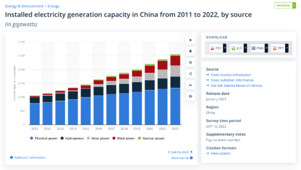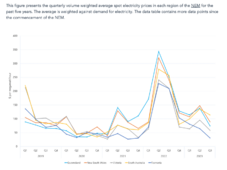You are using an out of date browser. It may not display this or other websites correctly.
You should upgrade or use an alternative browser.
You should upgrade or use an alternative browser.
China Installed More Solar Panels Last Year Than the U.S. Has in Total
- Thread starter fromport
- Start date
sunshine_eggo
Happy Breffast!
Good for them I guess?
Good for everybody. Anything that might reduce China's massive coal consumption is good for everyone that likes breathing.
China real estate has already hit the wall of overbuilding. Solar panels may come next. However it could still be quite a while.
Speaking of walls... I wonder when solar panels will cover more area and mass than the Great Wall??
Speaking of walls... I wonder when solar panels will cover more area and mass than the Great Wall??
wattmatters
Solar Wizard
Not seen full data showing 2023 numbers yet but I believe 2023 was the year where renewable / low carbon energy sources totalled more than 50% of electrical energy generation in China.
This was the trend data for electricity generation mix in China up to 2022:


 www.statista.com
www.statista.com
So yes, output from thermal coal generation has been increasing, however the rapid increase in wind and solar PV output has definitely reduced the rate of increase in use of fossil fuels and will begin to see a decline in coal consumption. The rate they are installing renewables is astonishing. It may not all be the most optimally sited, but frankly that's little different to using the space you have on an existing roof.
This was the trend data for electricity generation mix in China up to 2022:


China: power generation capacity by source 2022 | Statista
Thermal power plants accounted for the majority of installed power generating capacity in China.
So yes, output from thermal coal generation has been increasing, however the rapid increase in wind and solar PV output has definitely reduced the rate of increase in use of fossil fuels and will begin to see a decline in coal consumption. The rate they are installing renewables is astonishing. It may not all be the most optimally sited, but frankly that's little different to using the space you have on an existing roof.
100% this.If this is true, how come my electricity rates go up over time as solar plants are put in and coal plants shut down?
Chart shows one thing, my bill another.
I like to point out to rabid green people these three things:
- there are constant news headlines about "more wind/solar installed in [previous year] than any other year!"
- there are constant news headlines about how the price of new wind/solar is the lowest it's ever been
- their utility bill has never been higher
Brucey
Solar Wizard
Any reduction in costs to the utility providers simply goes to increased shareholder profits versus actual reductions in consumers power bills.100% this.
I like to point out to rabid green people these three things:
then I ask them: how can all three of these be true? the first reaction is almost always the "gears turning" look. then general confusion. universally, there is no good reconciliation of how these can all be true.
- there are constant news headlines about "more wind/solar installed in [previous year] than any other year!"
- there are constant news headlines about how the price of new wind/solar is the lowest it's ever been
- their utility bill has never been higher
houseofancients
Solar Wizard
I'm confused; are they still building coal plants, or solar, or both?
All depends on what article you open on google. More coal. Decommissioning coal. More solar, and every other variation.
IMO, coal is far more economical than solar panels, so I believe more coal plants are opening.
Think again
Still need storage.
Think again
houseofancients
Solar Wizard
Guess you missed those white square boxesStill need storage.
dougbert
Solar Addict
my bill is $20/month - but I installed my own system to MY SPECS and I run it myself
OK how about, still need a lot of expensive storage that is only good for short term before it needs to be replaced.Guess you missed those white square boxes
And building it out where there’s a lot of land available. Can you imagine the infrastructure to build transmission (wire, substations, etc) it to where people actually use the electricity?
Last edited:
It may be cheaper if you are the panel manufacturer ….. and the Govt can go round up a few villages of people in trucks to do the labor …That’s a pretty good start and trimming the prices.I don’t believe it’s cheaper and not sure everyone shares the concern of toxic coal ash.
BTW, look what happened to Jack Ma when he didn’t step in line with what the big whigs wanted..
No one gIves attitude in China very long without a visit from some govt boys.
Plus , Your correct, they have different standards of conduct and rules on environmental controls than we do……different in the respect of they don't have any concerns…they just do what they want To do…period….
J
wattmatters
Solar Wizard
Using simple memes and gotchas is unhelpful when considering the complexity of energy markets.then I ask them: how can all three of these be true?
I've no idea how the wholesale electricity market works where you are but here it's the generator of last resort which sets the price for any given interval. That's typically gas power generation - if it is required. When renewables are abundant, the price is very cheap, negative even (bulk users are paid to consume).
But when supply is constrained then gas sets the price. The international gas prices over the past year went berko, and so electricity prices here all went up sharply as a result. But they did not go up by nearly as much as they may have had it not been for the availability of renewables in our supply mix.
The faster we remove our reliance on gas generation here the more our prices will fall in line with the cheaper renewables supply and be less prone to international prices shocks.
The big increases in grid energy storage coming on line in the next few years (pumped hydro and battery) will see gas fall away as that supplier of last resort. It will still be there, but it will be called upon less often. It will take a while as we are still transitioning away from our last remaining coal power stations. Another decade and they will be gone.
Even so, there's a limit to the impact of wholesale electricity generation prices on retail tariffs.
Here the wholesale price of electricity is only ~2/5ths of the total cost of electrical energy delivered to consumers. The rest is the costs of transmission and distribution networks, market operational costs, retailer operating costs and margins. Largely these costs are independent of generation source, although there are some transmission network adjustments required to manage a more distributed energy generation system compared with the old paradigm of centralised generation.
But as a ROT, across Australia the states with the highest proportion of renewable energy supply now have lower wholesale electricity prices. This is seen in the price trend for fossil heavy states which has moved from being lowest wholesale price locations to the highest.

In order of highest proportion of renewables to lowest (% renewable energy over last 12 months):
Tasmania (93%)
South Australia (71%)
Victoria (42%)
NSW (31%)
QLD (28%)
Of the above, SA is most sensitive to fluctuations in gas prices, which is why they are continuing to deploy storage. The fossil heavy states are transitioning, just more slowly.
Tulex
Solar Wizard
Over 100 new coal plants approved in 2022. Their solar and wind makes up 2% of their power.
“Gas” No mention of modern nuclear plants deploying the latest modular design technology.Using simple memes and gotchas is unhelpful when considering the complexity of energy markets.
I've no idea how the wholesale electricity market works where you are but here it's the generator of last resort which sets the price for any given interval. That's typically gas power generation - if it is required. When renewables are abundant, the price is very cheap, negative even (bulk users are paid to consume).
But when supply is constrained then gas sets the price. The international gas prices over the past year went berko, and so electricity prices here all went up sharply as a result. But they did not go up by nearly as much as they may have had it not been for the availability of renewables in our supply mix.
The faster we remove our reliance on gas generation here the more our prices will fall in line with the cheaper renewables supply and be less prone to international prices shocks.
The big increases in grid energy storage coming on line in the next few years (pumped hydro and battery) will see gas fall away as that supplier of last resort. It will still be there, but it will be called upon less often. It will take a while as we are still transitioning away from our last remaining coal power stations. Another decade and they will be gone.
Even so, there's a limit to the impact of wholesale electricity generation prices on retail tariffs.
Here the wholesale price of electricity is only ~2/5ths of the total cost of electrical energy delivered to consumers. The rest is the costs of transmission and distribution networks, market operational costs, retailer operating costs and margins. Largely these costs are independent of generation source, although there are some transmission network adjustments required to manage a more distributed energy generation system compared with the old paradigm of centralised generation.
But as a ROT, across Australia the states with the highest proportion of renewable energy supply now have lower wholesale electricity prices. This is seen in the price trend for fossil heavy states which has moved from being lowest wholesale price locations to the highest.
View attachment 192309
In order of highest proportion of renewables to lowest (% renewable energy over last 12 months):
Tasmania (93%)
South Australia (71%)
Victoria (42%)
NSW (31%)
QLD (28%)
Of the above, SA is most sensitive to fluctuations in gas prices, which is why they are continuing to deploy storage. The fossil heavy states are transitioning, just more slowly.
wattmatters
Solar Wizard
I think you have that mixed up.Over 100 new coal plants approved in 2022. Their solar and wind makes up 2% of their power.
It's nuclear that's just 2% of their total electricity generation.
Solar PV and wind contributed 30% of China's electrical energy total supply in 2022 and is growing very rapidly (especially solar PV).
Thermal fossil (coal/gas) supply 52%
Hydro 16%
Coal power is still growing, but relatively slowly and coal power output is expected to peak some time next year before beginning to decline. Wind and solar PV in particular have grown very strongly, far outstripping the growth in energy generation by other sources.
wattmatters
Solar Wizard
We have no nuclear power in Australia so none to mention.“Gas” No mention of modern nuclear plants deploying the latest modular design technology.
As to the latest modular nuclear designs, financially they have been a disaster in Western nations. There are none in operation so the real costs are unknown, other than they have been unable to reach financial viability despite massive government support.
My rates went up a fair chunk because Biden sold our natural gas to Europe because the Germans were freezing their butts off because they made themselves too reliant on Russian gas when Trump warned them not to and they laughed at him, then Putin invaded Ukraine and everyone threw sanctions on Russia and some idiot blew up Nord Stream 
Ok that's a bit of an over simplification of things but you get the idea.
Ok that's a bit of an over simplification of things but you get the idea.
I believe your navy does. And you guys ship a lot of uranium to China.We have no nuclear power in Australia so none to mention.
As to the latest modular nuclear designs, financially they have been a disaster in Western nations. There are none in operation so the real costs are unknown, other than they have been unable to reach financial viability despite massive government support.
Similar threads
- Replies
- 2
- Views
- 281
- Replies
- 50
- Views
- 4K
- Replies
- 12
- Views
- 600
- Replies
- 16
- Views
- 616
- Replies
- 15
- Views
- 427



